Owlman-Aligned Surrealist Dies
Posted by: Loren Coleman on May 27th, 2011
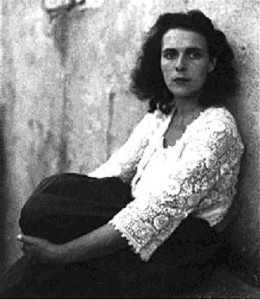
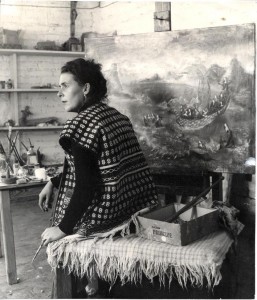
Leonora Carrington (April 6, 1917 – May 25, 2011) was a British-born Mexican artist, surrealist painter, novelist – and former girlfriend of Max Ernst. She lived most of her life in Mexico City. Carrington has passed away at 94. Part of her life is a sad love story surrounded by passionate art, involving Max Ernst.
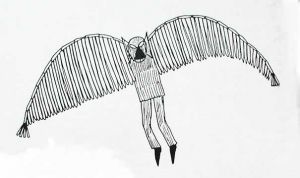
Ernst’s name is forever tied to the Owlman. The Owlman, sometimes referred to as the Cornish Owlman, or The Owlman of Mawnan, is a purported avian cryptid that was allegedly sighted around mid-1976 in the village of Mawnan, Cornwall. The Owlman is sometimes compared to America’s Mothman in cryptozoological literature.

Leonora Carrington’s painting, The Night of the 8th.
The Owlman story began when paranormal researcher Tony “Doc” Shiels was approached by a man, Don Melling, who had been visiting the area on holiday from Lancaster. Melling said that on April 17, 1976, his two daughters, 12-year-old June and her 9-year-old sister, Vicky, were walking through the woods near Mawnan church when they saw a large winged creature hovering above the church tower. The girls were frightened and immediately ran to tell their father.

According to Shiels, the family had become so perturbed by the sighting that they had abandoned their holiday three days early and that the father would not allow either of his daughters to be interviewed. Sheils was, however, provided with a drawing of the creature made by twelve year old June.
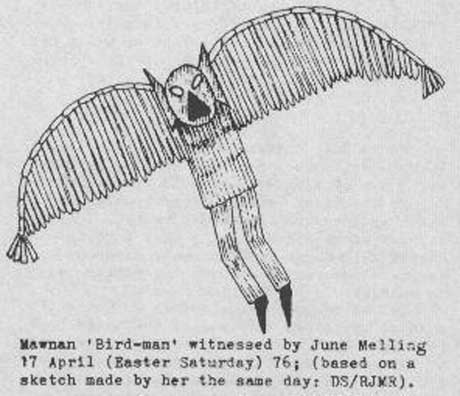
Soon a second sighting followed, and other modern sightings have occurred, although some investigators have discussed the story in terms of Shiels’ trickery and magic.
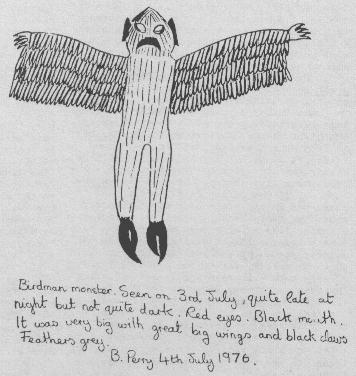
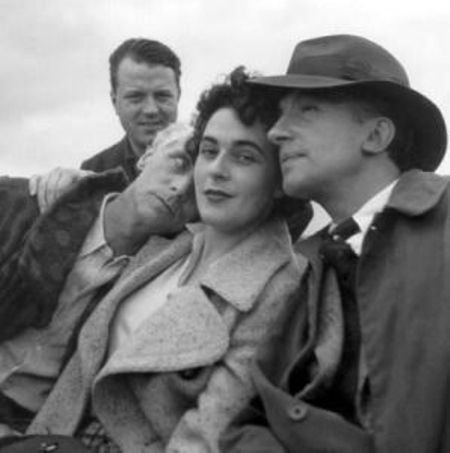
Lee Miller – ELT Mesens, Max Ernst, Leonora Carrington and Paul Eluard, Lamb Creek, Cornwall England, 1937
Shiels has suggested himself that surrealism may hold the key. Sixteen days before the first recorded sighting of the Owlman the surrealist artist Max Ernst died. In 1937 Ernst had visited the area with friends (apparently including Carrington according to photographs from that time) and performed rituals to invoke the appearance of all sorts of mysterious creatures. One of these may have been Nightjarman, half bird, half human.
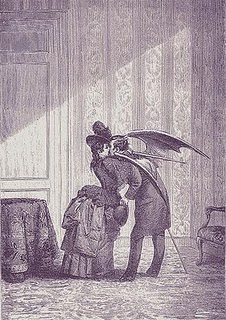
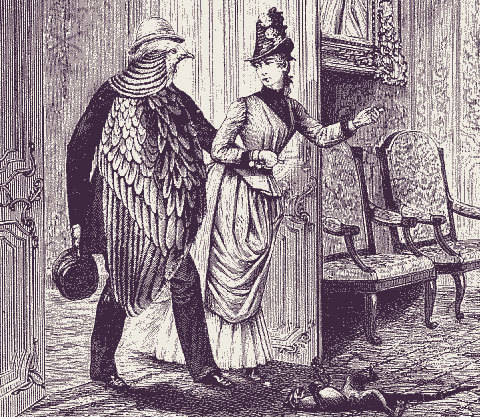
Indeed, Max Ernst did develop a fascination with birds that was prevalent in his work (as shown in the two images directly above). His alter ego in paintings, which he called Loplop, was a bird. He suggested this alter-ego was an extension of himself stemming from an early confusion of birds and humans. He said that one night when he was young he woke up and found that his beloved bird had died, and a few minutes later his father announced that his sister was born. Loplop often appeared in collages of other artists’ work, such as Loplop presents André Breton.
In 1927 he married Marie-Berthe Aurenche, and it is thought his relationship with her may have inspired the erotic subject matter of The Kiss and other works of this year. In 1930, he appeared in the film L’Âge d’Or, directed by self-identifying Surrealist Luis Buñuel. Ernst began to make sculpture in 1934, and spent time with Alberto Giacometti. In 1938, the American heiress and artistic patron Peggy Guggenheim acquired a number of Max Ernst’s works which she displayed in her new museum in London. Ernst and Peggy Guggenheim were also married to one another from 1942 to 1946.
In 1938 he was interned in Camp des Milles, near Aix-en-Provence, along with fellow surrealist, Hans Bellmer, who had recently emigrated to Paris on the outbreak of World War II. Thanks to the intercession of Paul Éluard and other friends, including the journalist Varian Fry, he was discharged a few weeks later. Soon after the Nazi occupation of France, he was arrested again, this time by the Gestapo, but managed to escape and flee to America with the help of Guggenheim. He left behind his lover, Leonora Carrington, and she suffered a major mental breakdown. Ernst and Guggenheim arrived in the United States in 1941 and were married the following year. Along with other artists and friends (Marcel Duchamp and Marc Chagall) who had fled from the war and lived in New York City, Ernst helped inspire the development of Abstract expressionism.
Carrington was born in Clayton Green, Chorley, Lancashire, England. Her father was a wealthy textile manufacturer her mother was Irish. She also had an Irish nanny, Mary Cavanaugh, who told her Gaelic tales. Leonora had three brothers. Places she lived as a child included a house called Crookhey Hall.
Educated by governesses, tutors and nuns, she was expelled from two schools for her rebellious behavior until her family sent her to Florence where she attended Mrs. Penrose’s Academy of Art. Her father was opposed to an artist’s career for her, but her mother encouraged her. She returned to England and was presented at Court, but according to her, she brought a book to read by Aldous Huxley Eyeless in Gaza (1936), instead. In London she attended the Chelsea School of Art and joined the Academy of Amédée Ozenfant.
She saw her first Surrealist painting in a Left Bank gallery in 1927 (when she was ten years old), and met many surrealists, including Paul Éluard. She was already familiar with surrealism from Herbert Read’s book.
Leonora Carrington found little encouragement from her family to forge an artistic career. Matthew Gale, curator at Tate Modern, singled out Surrealist poet and patron Edward James as the only champion of her work in Britain. James bought many of her paintings, and in 1947 arranged a show for her work at Pierre Matisse’s Gallery in New York. Some works are still hanging at his former family home now West Dean College in West Dean, West Sussex.
Carrington saw Max Ernst’s work in the 1936 International Surrealist Exhibition in London where she was immediately attracted to the Surrealist artist before actually meeting him.

Carrington and Ernst, 1937
She met Max Ernst at a party in London in 1937 (apparently around the same time he was doing the rituals in Cornwall). The artists bonded and returned to Paris together where Ernst promptly separated from his wife. In 1938 they left Paris and settled in Saint Martin d’Ardèche in the garrigue, in the south of France. The new couple collaborated and supported each other’s artistic development. With the outbreak of World War II, as noted, Max Ernst was arrested by French authorities for being a “hostile alien.” Thanks to the intercession of Paul Éluard, and other friends including the American journalist Varian Fry he was discharged a few weeks later.
Soon after the Nazi occupation of France, Ernst was arrested again, this time by the Gestapo. He managed to escape and flee to America with the help of Peggy Guggenheim, a sponsor of the arts. After Ernst’s arrest, a devastated Carrington fled to Spain. Paralysing anxiety and growing delusions culminated in a final breakdown at the British embassy in Madrid. Her parents intervened and had her institutionalized. She was given cardiazol, a powerful GABA stimulator that was eventually banned by the U.S. Food and Drug Administration (FDA) and other authorities. After being released into the care of a nurse who took her to Lisbon, Carrington ran away and sought refuge in the Mexican Embassy. Meanwhile, Ernst had been extricated from Europe with the help of Peggy Guggenheim, but Ernst and Carrington had experienced so much misery that they were unable to reconnect.
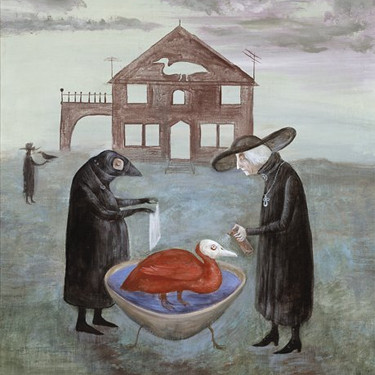
Bird Bath, Leonora Carrington.
The first important exhibition of her work appeared in 1947 at the Pierre Matisse Gallery in New York City. Leonora Carrington was invited to show her work in an international exhibition of Surrealism where she was the only female English professional painter. She became a celebrity almost overnight. In Mexico she authored and has successfully published several books.The first major exhibition of her work in the UK for twenty years took place at Chichester’s Pallant House Gallery, West Sussex from 17 June to 12 September 2010 as part of a season of major international exhibitions called Surreal Friends, celebrating the place of women in the Surrealist movement. Her work was exhibited alongside pieces by her close friends the Spanish painter Remedios Varo (1908–1963) and the Hungarian photographer Kati Horna (1912–2000).
Following the escape to Lisbon, Carrington arranged passage out of Europe with a Mexican diplomat (Renato Leduc), who was a friend of Picasso and who had agreed to marry Carrington as part of the travel arrangements to help her. Events from that period would inform her work perhaps forever. She lived and worked in Mexico after spending part of the 1960s in New York City.
“I didn’t have time to be anyone’s muse… I was too busy rebelling against my family and learning to be an artist.” –Leonora Carrington, 1983
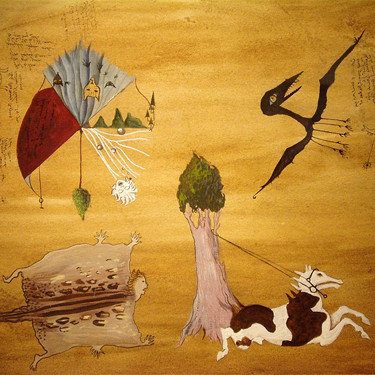
Untitled, Leonora Carrington.
“She created mythical worlds in which magical beings and animals occupy the main stage, in which cobras merge with goats and blind crows become trees,” the National Arts Council wrote, adding, “These were some of the images that sprang from a mind obsessed with portraying a reality that transcends what can be seen.”
Mexican author Elena Poniatowska was a longtime friend of the artist and wrote the novel Leonora based on her life.
In Mexico she later married Emericko Weisz. They had two sons: Gabriel Weisz, an intellectual and a poet, and Pablo Weisz, a surrealist artist and doctor.
Leonora Carrington died in Mexico City on Wednesday May 25, 2011 while hospitalized due to complications from pneumonia.
Thanks to Nick Redfern for the initial news of her death. The above details of her life and its relationship to Ernst and the Owlman events are my compilation. ~ Loren.
About Loren Coleman
Loren Coleman is one of the world’s leading cryptozoologists, some say “the” leading living cryptozoologist. Certainly, he is acknowledged as the current living American researcher and writer who has most popularized cryptozoology in the late 20th and early 21st centuries.
Starting his fieldwork and investigations in 1960, after traveling and trekking extensively in pursuit of cryptozoological mysteries, Coleman began writing to share his experiences in 1969. An honorary member of Ivan T. Sanderson’s Society for the Investigation of the Unexplained in the 1970s, Coleman has been bestowed with similar honorary memberships of the North Idaho College Cryptozoology Club in 1983, and in subsequent years, that of the British Columbia Scientific Cryptozoology Club, CryptoSafari International, and other international organizations. He was also a Life Member and Benefactor of the International Society of Cryptozoology (now-defunct).
Loren Coleman’s daily blog, as a member of the Cryptomundo Team, served as an ongoing avenue of communication for the ever-growing body of cryptozoo news from 2005 through 2013. He returned as an infrequent contributor beginning Halloween week of 2015.
Coleman is the founder in 2003, and current director of the International Cryptozoology Museum in Portland, Maine.










Thank you so much for writing this eulogy, Loren –I didn’t have a Internet connection yesterday, so that’s why I’m replying so late.
Indeed, news that Leonora died shook all of Mexico last Thursday. She was a beloved artist and something of a national treasure. It kind of makes me sad to think that once Mexico was a safe haven for intellectuals and artists that were fleeing from the madness and violence that plagued Europe; and now… 🙁
Descanse en Paz.